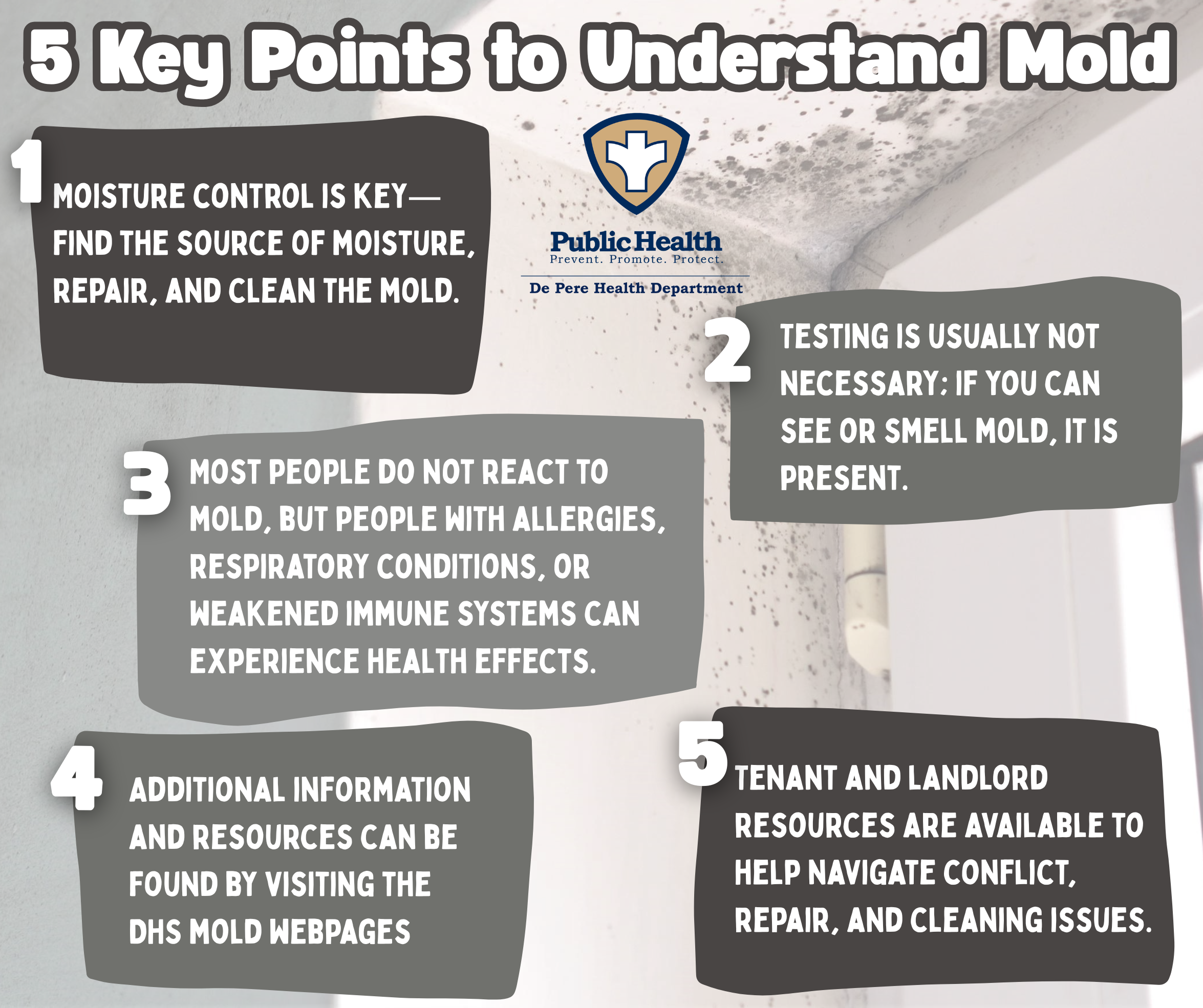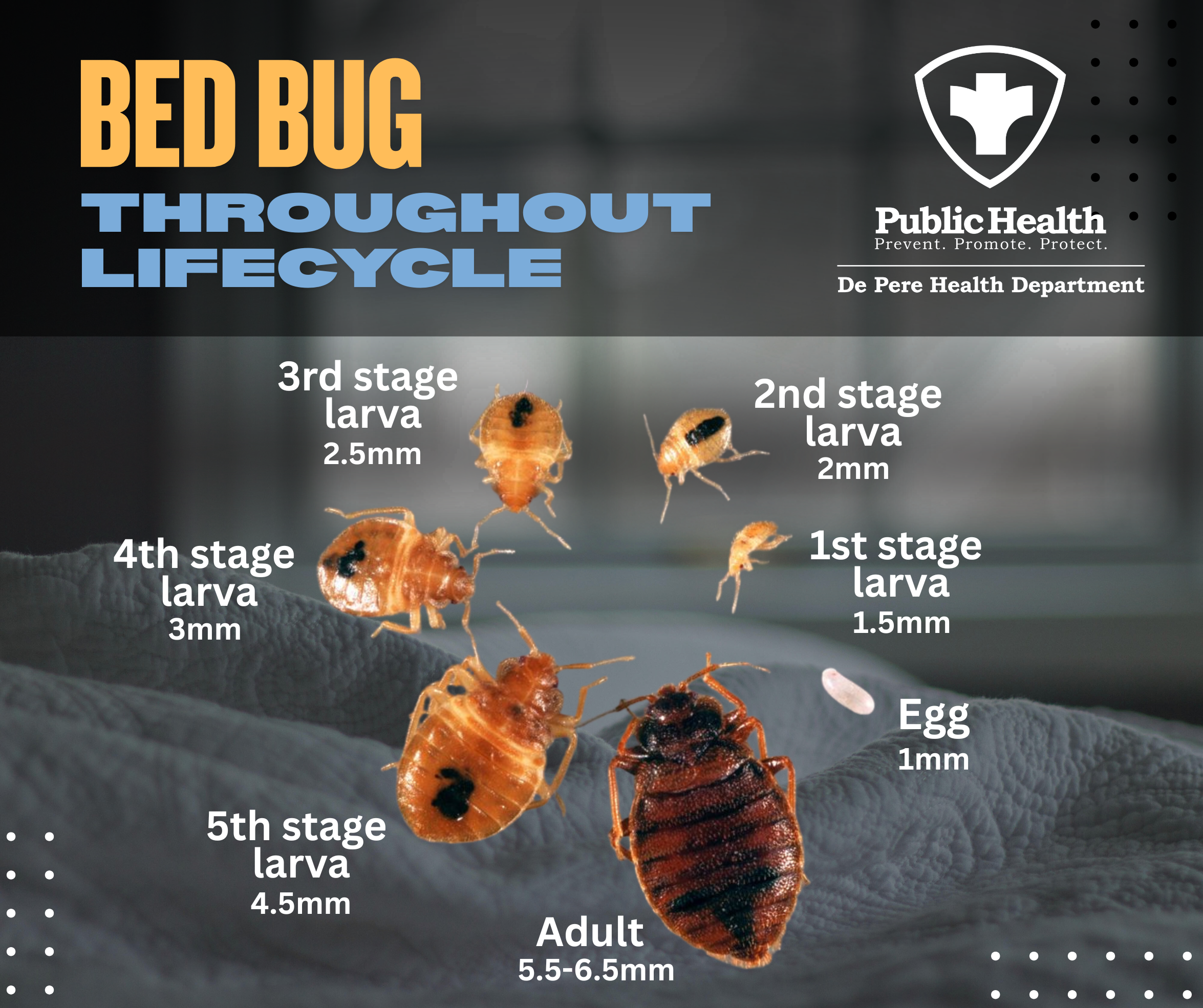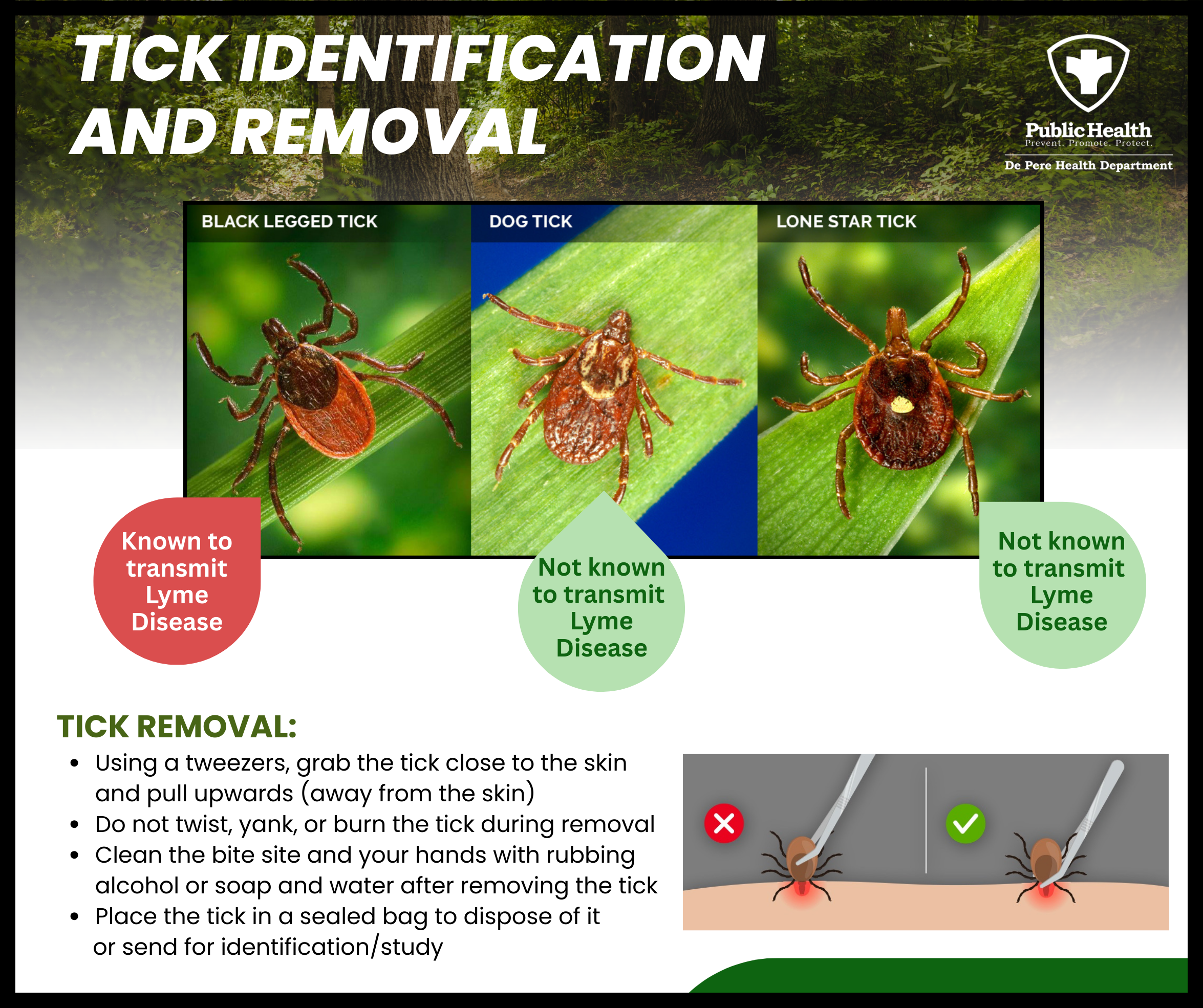Environmental Hazards & Nuisances
Maintaining safe environments
The De Pere Health Department works to prevent and reduce risks to human health and the environment from environmental hazards.
Find more information about
- Mold
- Radon
- Noise
- Bedbug Information
- Ticks & Lyme Disease
- Landlord Tenant Concerns
Mold
The De Pere Health Department can provide resources and guidance to De Pere residents to help them understand mold as it relates to health, how to prevent mold growth, and how to fix indoor mold problems.
Mold spores are constantly traveling through the air all around us and can be found both indoors and outdoors. It is not practical to expect a building or home to be completely free of mold; however, indoor mold growth can be prevented and controlled.

For more information, visit the DHS mold webpages
Radon
- Radon is a naturally occurring, radioactive gas that can cause lung cancer.
- Radon can leak into your home and is common in Wisconsin.
- While you can't see or smell it, you can protect yourself from it.
Testing for radon is common when buying or selling a home, but you should take action now. Testing your home is the only way to know if you and your family are at risk for radon. This is an important first step to know your home’s radon level.
A short-term test kit can be purchased from De Pere Health Department for $10. Please call our office at 920-339-4054 for availability.
Please refer to the following website for detailed information on Radon: https://www.dhs.wisconsin.gov/radon/index.htm
Noise
Complaints of community noise can be directed to the De Pere Police Department (afterhours) or the De Pere Health Department. Noise is regulated through the Municipal Code of Ordinances Chapter 146 and is based on zoning and time of day.
When contacting the City with a complaint of noise, the more information you can provide, the better we can assist you. Providing the source of the noise and specific times of the day or night the noise is being heard are very helpful to our investigation.
To reach the De Pere Health Department during the work day, please call 920-339-4054.
To reach the De Pere Police Department after hours, please call 920-339-4078 (you may be redirected to Brown County dispatch)
Noise variances may be obtained from the De Pere Health Department for special events. Follow this link to apply: Noise variance application. The cost is $30 per application. Applications may include up to 4 event dates each. Detailed information about noise variance requirements can be found in Municipal Code 106-6(d).
Bedbug Information
The common bed bug has long been a pest – feeding on blood, causing itchy bites and generally irritating their human hosts. The Environmental Protection Agency (EPA), the Centers for Disease Control and Prevention (CDC), and the United States Department of Agriculture (USDA) all consider bed bugs a public health pest. However, unlike most public health pests, bed bugs are not known to transmit or spread disease.
They can, however, cause other public health issues, so it’s important to pay close attention to preventing and controlling bed bugs.
Experts believe the recent increase in bed bugs in the United States may be due to more travel, lack of knowledge about preventing infestations, increased resistance of bed bugs to pesticides, and ineffective pest control practices.
The good news is that there are ways to control bed bugs. Getting good, solid information is the first step in both prevention and control. While there is no chemical quick fix, there are effective strategies to control bed bugs involving both non-chemical and chemical methods.
Bed bugs can be hard to find and identify, given their small size and their habit of staying hidden. It helps to know what they look like, since the various life stages have different forms.

For detailed information about bedbugs, please follow this link: https://www.epa.gov/bedbugs
Ticks & Lyme Disease
What to Know About Ticks?
- Ticks can spread many common diseases including Lyme Disease.
- There are many kinds of ticks. Not all ticks spread disease. You won't get sick from every tick bite.
- Three kinds of ticks spread disease in Wisconsin: deer (black-legged) ticks, wood (dog) ticks, the lone star ticks.
- Ticks are most active in spring, summer, and early fall. This is when bites are most common. Ticks usually live in tall grass, wooded areas, and bushes.
- Ticks don’t jump or fly. They only crawl onto you or your pet when you brush up against them.
How to Prevent Tick Bites
- Ticks feed by biting skin. While they are attached to skin, they can spread disease.
- Simple steps can help prevent bites from ticks:
- Check for ticks on anyone outside during tick season, including pets. Be sure to check your whole body!
- Use repellant on skin and cloths when going outdoors. Your veterinarian can help with tick prevention treatment for your pets.
- Wear long pants and long sleeves to keep ticks off your skin. Tuck in pant legs and shirts. Bright colored cloths help make ticks easier to see.
- Try to avoid direct contact with ticks by walking in the center of trails where grass and shrubs are shorter.
- Tumble cloths you’ve worn on high heat, to kill any ticks on clothing.
How Remove a Tick
- If you find a tick attached to a person or a pet, remove it as soon as possible.
- Using a tweezer hold close to the tick’s head and pull upward with steady pressure. Ticks can be as small as a poppy seed or sesame seed. It’s important that ticks be removed completely.
- Don't squeeze, crush, twist or puncture the body of the tick. This can spread disease.
- After removing the tick, use rubbing alcohol to clean the bite site.
- Wash hands thoroughly.
- Visit a doctor if you have a rash or fever within 30 days of removing a tick.
- FREE tick prevention and removal kits are available at the De Pere Health Department. Stop in anytime during normal business hours.
Tickborne Illness and Symptoms
- You can start to feel sick from an infected tick bite between three and 30 days. Some symptoms may take longer to show.
- Fever, rash, chills, headache, fatigue, muscle or joint aches, or swollen lymph nodes are common symptoms of tickborne diseases. If you have spent time outside and have symptoms, talk to your healthcare provider, even if you haven't seen a tick on your body or a rash.
- A bullseye rash around or near a tick bite is a common symptom of Lyme disease. If you see a bullseye rash, call your healthcare provider. Find more information on Lyme disease here.
Tick Identification and Testing
Find a tick on you, your family or your pet? You can submit it for identification to the Wisconsin Department of Health Services or submit it to the Marshfield Clinic Research Institute for a surveillance study!
For more information about tick identification through the Wisconsin Department of Health Services, visit: Wisconsin DHS Tick Identification
For information on the Marshfield Clinic Tick Study, visit: Marshfield Tick Study Information
Pre-paid collection kits for the Marshfield study are available at the De Pere Health Department!

Landlord Tenant Concerns
Tenant/Landlord Hotline - 800-422-7128
This service is provided by the Wisconsin Department of Trade, Agriculture and Consumer Protection. Consumers should contact this agency when problems arise with your landlord on issues that are not health related. This would include issues such as failure to provide services outlined in your lease, landlord harassment and building negligence.
